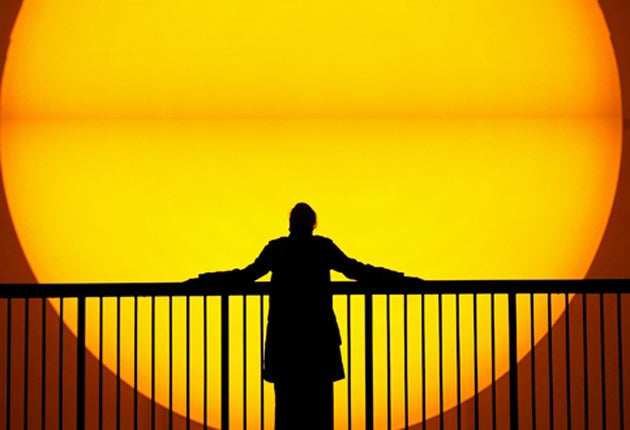Chasing The Sun, By Richard Cohen

Your support helps us to tell the story
From reproductive rights to climate change to Big Tech, The Independent is on the ground when the story is developing. Whether it's investigating the financials of Elon Musk's pro-Trump PAC or producing our latest documentary, 'The A Word', which shines a light on the American women fighting for reproductive rights, we know how important it is to parse out the facts from the messaging.
At such a critical moment in US history, we need reporters on the ground. Your donation allows us to keep sending journalists to speak to both sides of the story.
The Independent is trusted by Americans across the entire political spectrum. And unlike many other quality news outlets, we choose not to lock Americans out of our reporting and analysis with paywalls. We believe quality journalism should be available to everyone, paid for by those who can afford it.
Your support makes all the difference.A Chinese-made portable solar-powered lamp and charger was the final object chosen by Neil MacGregor, director of the British Museum, in his A History of the World in 100 Objects. It was a choice that few would have predicted, but once its solar panel captures and stores the energy of eight hours of sunshine, this 21st-century lamp converts it into 100 hours of light to be used whenever and wherever needed. "The power of the Sun seems a good place to end this global history," said MacGregor, "because solar energy is a dream of the future that echoes the oldest and most universal of human myths, that of the life-giving Sun."
Richard Cohen has produced an encyclopaedia of a book that could almost serve as a companion to MacGregor's landmark series – an alternative history of the world told through humanity's relationship with a single object.
He begins with the myth of the Sun as the god Inti, of the tribes of Peru and northern Chile, who descended into the ocean every evening, swam back to the east, then reappeared, refreshed by his bath. The Hopi of Arizona claim that they made the Sun by throwing up a buckskin shield along with a fox's coat and a parrot's tail, to make the colours of sunrise and sunset.
"The Sun is 32,000 light years from the centre of its galaxy of a hundred billion stars, which it orbits at about 155 miles a second, taking about 200 million years to complete a revolution," reports Cohen. The Sun has been active for 4.6 billion years and a single particle of light, a photon, from its core takes 150,000 years to reach space. Every second, about five million metric tonnes of mass are converted into nuclear energy: equivalent to the detonation of 90,000 million one-megaton hydrogen bombs. The numbers are mind-boggling, but this constant blast of nuclear reactions pushes energy to the surface, releasing it as light and heat.
The Earth receives more of this energy in just 45 minutes than its inhabitants consume in a year. About 35 per cent is reflected back into space by clouds and the atmosphere absorbs another 19 per cent. This still leaves 12,000 times as much energy as used by all man-made devices.
Effectively harnessing the sun is not just a modern ambition. The Greeks in the third century BC used "burning mirrors" to focus sunlight on enemy warships. Archimedes, so legend has it, deployed such mirrors in 212BC to defend Syracuse from a blockading Roman fleet by burning the enemy's sails.
The Romans were the first to build greenhouses. In the sixth century, the Emperor Justinian passed a law protecting public and domestic sunrooms from the erection of buildings that obstructed light; 1,000 years later, Leonardo da Vinci proposed using a giant mirror as a commercial source of heat.
Like some latter-day Victorian species hunter who travels the globe collecting new specimens, Cohen spent eight years chasing the sun across 18 countries and six continents. He began with a climb to the top of Mount Fuji to watch the sunrise on the summer solstice and ended in a sunset viewed from a boat on Ganges at Varanasi.
Among other trips, Cohen recounts seeing an eclipse on the Antarctic ice. He visits the Arctic city of Tromso in Norway, which for ten weeks each year receives virtually no sunlight (a period the locals call "the dark times"), to investigate how we react to the loss of light.
Among Cohen's treasure-trove of solar miscellanea is the "sunspot cycle" in modern economics, the story of sundials and calendars from Julius Caesar to Pope Gregory VII, the introduction of daylight saving time in 1916 as a wartime economic measure, and a brief history of navigation and cartography. He shows how the Babylonians were the first to record the sun's movements in detail, while the Greeks went further, inquiring into its size, shape, and distance from the Earth.
Occasionally Cohen's passion for all things solar gets the better of him, as when he suggests that the lingams of Hindu temple domes are "purposely imitated in the design of nuclear-reactor cones, the latest tribute to the sun's potency". Yet he can be forgiven, as we learn how artists from the Renaissance to Hockney have depicted the Sun, or of Shakespeare's enthusiasm for suntans. We see why Galileo recorded his discovery of sunspots in code, why Matisse rushed out of his dying wife's bedroom, why Wagner hated the Sun and Mozart loved it.
All things come to an end, and Cohen devotes a chapter to the death of the Sun. As I read it I remembered the first part of a poem of Francis William Bourdillon: "The night has a thousand eyes,/ And the day but one;/ Yet the light of the bright world dies/ With the dying of the sun."
Manjit Kumar's 'Quantum' is published by Icon
Join our commenting forum
Join thought-provoking conversations, follow other Independent readers and see their replies
Comments